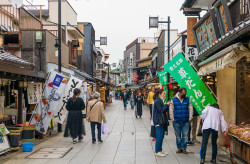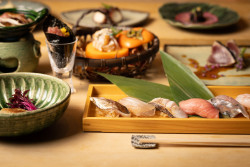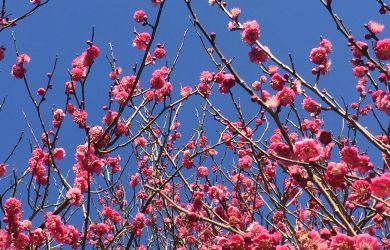
April 7, 2011
Dewa Sanzan
In the realm of yamabushi ascetics and ancient living Buddhas
By Metropolis
Originally published on metropolis.co.jp on April 2011

Alena Eckelmann

Courtesy Yamagata Prefectural Government

Alena Eckelmann

Alena Eckelmann
These are the yamabushi (“one who lies in the mountains”), and modern mortals can still follow their pilgrimage in Dewa Sanzan– the three mountains of Dewa–one of two main centers in Japan where shugenja (followers of Shugendo) still practice and keep the tradition alive.
Dewa is the name of an old Japanese province that is now part of Yamagata Prefecture in northern Honshu. Three mountains—Mt. Haguro, Mt. Gassan and Mt. Yudono—are considered sacred by the shugenja who go there once a year on a pilgrimage to practice their faith.
Travel there in the right season and you can follow the alpenhorn-like sound of the conch shell, blown by yamabushi masters decked out in esoteric outfits, as they lead rows of white-clad pilgrims up the mountains. New Age is short lived in comparison to this syncretistic folk religion based on mountain worship, incorporating elements of Shinto, Buddhism and Taoism that dates back over 1,400 years.
Traditionally, the pilgrimage route starts at Toge, a small village at the foot of Mt. Haguro. Pilgrims walk up a 1.7km long stone path, the Ishi-dan, set amongst a forest of 350- to 500-year-old Cryptomeria trees, before reaching the summit where they pray to three deities, one for each mountain peak, at the Sanjin Gosaiden shrine.
In the old days people walked, but many modern-day pilgrims can’t resist the shortcut of catching a bus that takes them from Mt. Haguro to Mt. Gassan. Some slopes of the 2,000 meter-high Gassan are covered in snow even in mid-summer, providing an unusual sight. Yudono shrine is not located on the summit of Mt. Yudono but in a valley with a descent so steep that steel ladders and ropes must be used by pilgrims and adventurers alike.
Historically, women were forbidden to worship at the shrine. They were only allowed as near as Dainichibo, a temple at the foot of Mt. Yudono. It is said to have been established by Kobodaishi (774-835), the founder of the Shingon sect of Buddhism and probably Japan’s best known saint.
Legend has it that after coming back from China where he underwent Buddhist training, Kobodaishi petitioned the ruler at the time to build a temple. Baffled about where the location should be, he threw two ritual objects used in Buddhist ceremonies into the air. The first hit a cedar tree standing near Dainichibo, and the second hit a pine tree on Mt. Koya. He promptly established a temple at each site, both of which are still places of worship, as are the trees that still stand there today.
The main attraction at Dainichibo, however, is a fellow named Daijuku Bosatsu Shinnyokai Shonin. He is one of a number of so-called “Living Buddhas” that can be found in temples in the Yamagata area. They appear much like mummies in priest’s robes. However, unlike their famous counterparts in Egypt, they were not mummified after death. They self-mummified themselves while still alive by following a severe ascetic routine as part of their Buddhist religious training.
While ascetic exercises are not for everyone, mere mortals can simply meditate in the superb mountain scenery of the Dewa Sanzan area. Enjoy your own spiritual awakening: catch a glimpse of some fascinating esoteric traditions that reveal the mystical side of Japan so often forgotten in the urban jungle of Tokyo.
Trip Tips
 The Joetsu shinkansen is a two-hour train ride from Tokyo to Niigata. From there, travel two hours on the Uetsu Main Line to Tsuruoka City. A bus to Mt. Haguro takes 40 minutes from the bus stop in front of the station. The best time to travel is July to October, as Mt. Gassan and Mt. Yudono are not accessible for trekking during other times of the year. The local tourist information office, also located in front of the station, has English pamphlets about the area available.
The Joetsu shinkansen is a two-hour train ride from Tokyo to Niigata. From there, travel two hours on the Uetsu Main Line to Tsuruoka City. A bus to Mt. Haguro takes 40 minutes from the bus stop in front of the station. The best time to travel is July to October, as Mt. Gassan and Mt. Yudono are not accessible for trekking during other times of the year. The local tourist information office, also located in front of the station, has English pamphlets about the area available.
Alternatively, you can download the information from www.tsuruokakanko.com/english/haguro.html or call the Shonai Visitors Association on 0235-68-2511.







